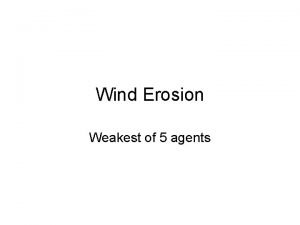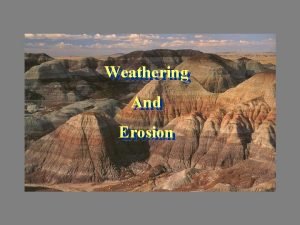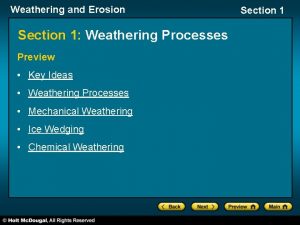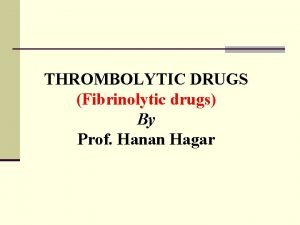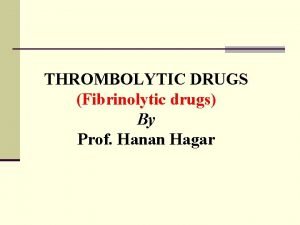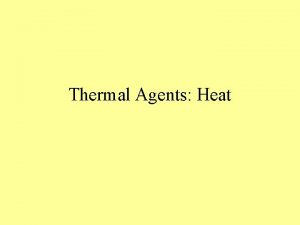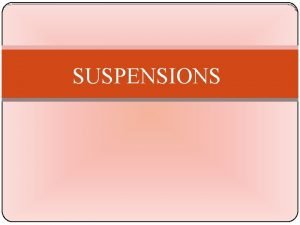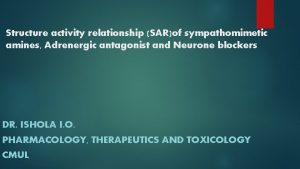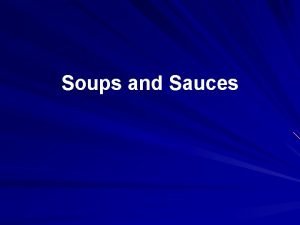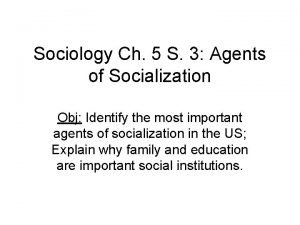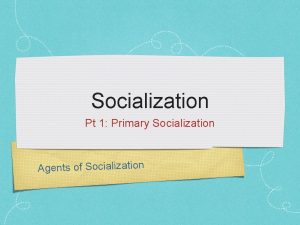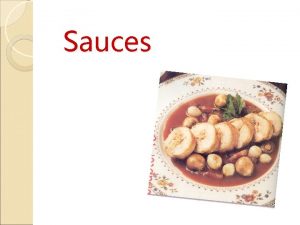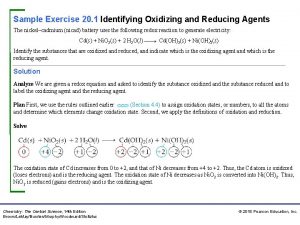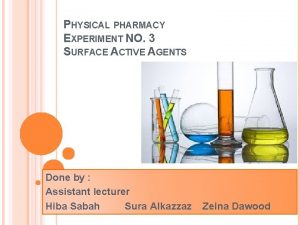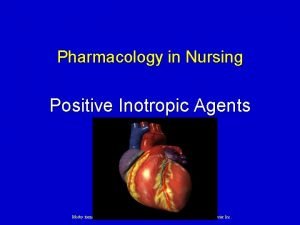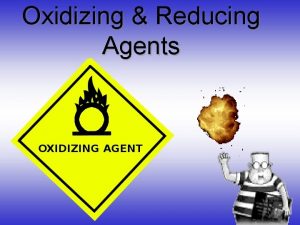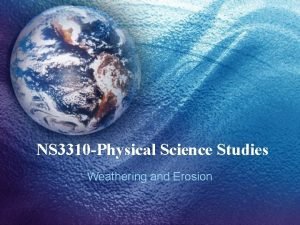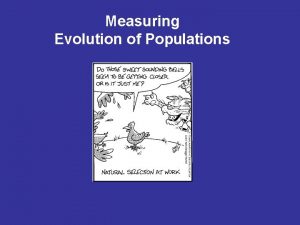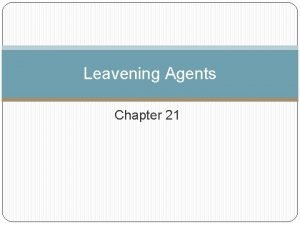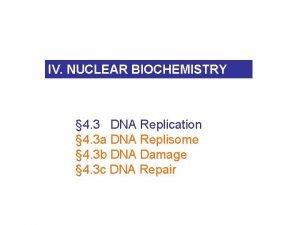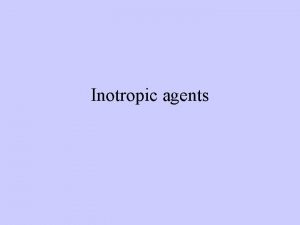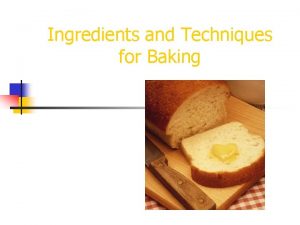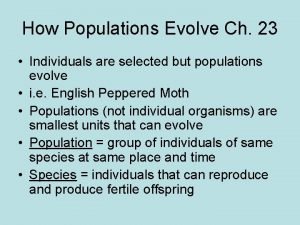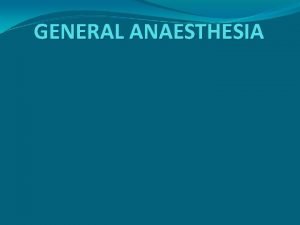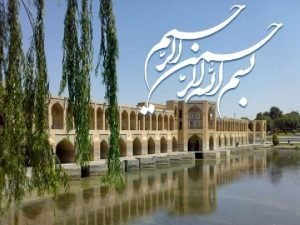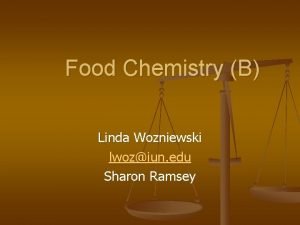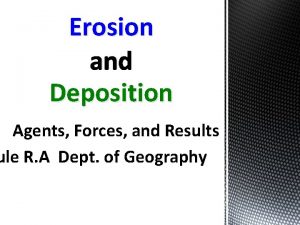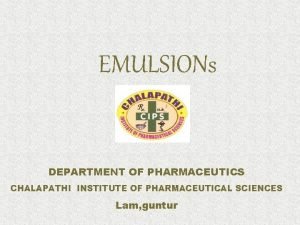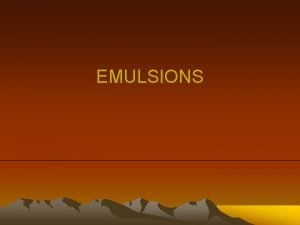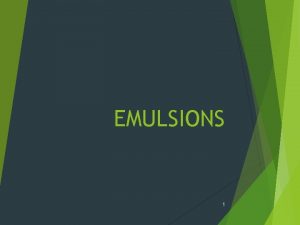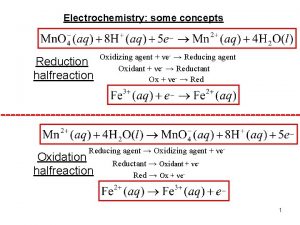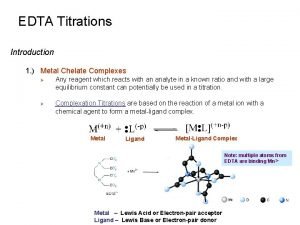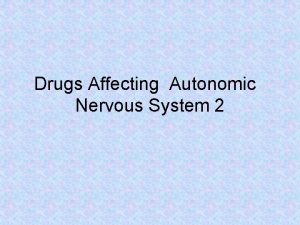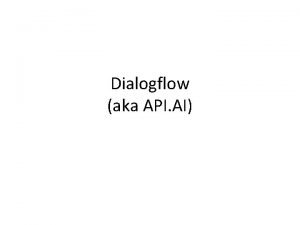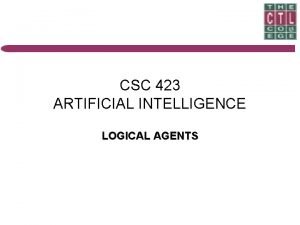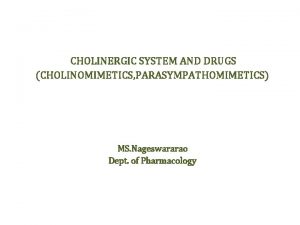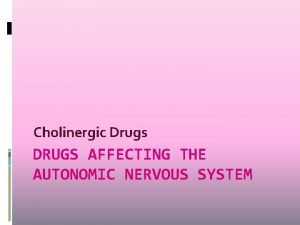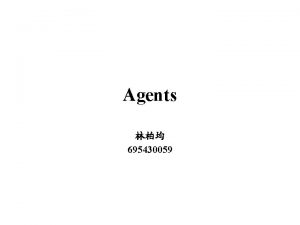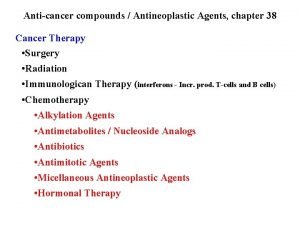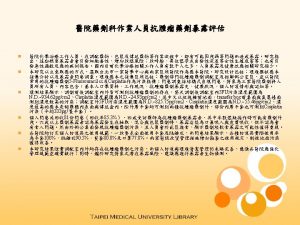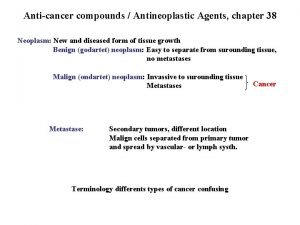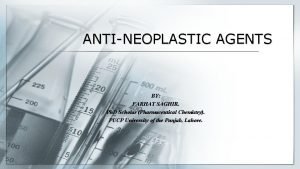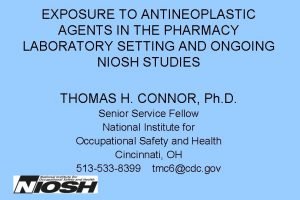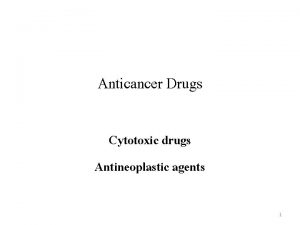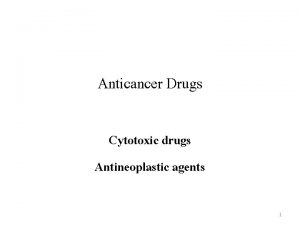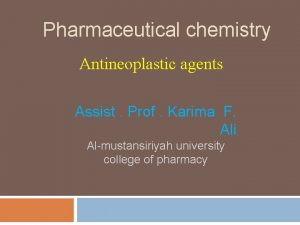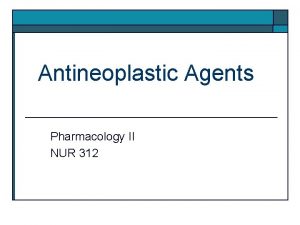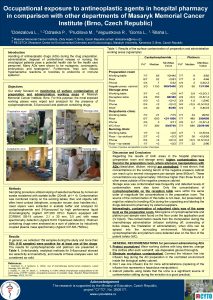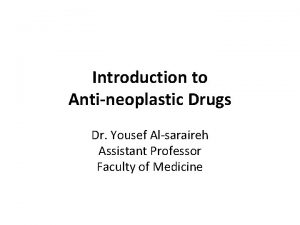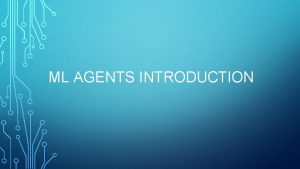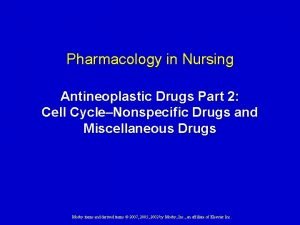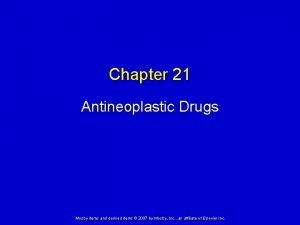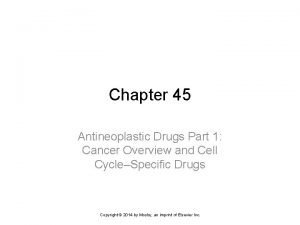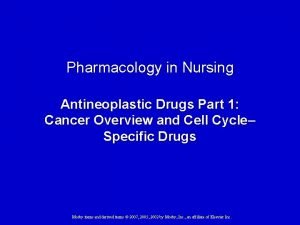ANTINEOPLASTIC AGENTS 1 SECTION 1 Introduction SECTION 2















































![* Mitoxantrone (Novantrone,米托蒽醌) 1, 4 -dihydro-5, 8 -bis[[2 -[(2 -hydroxyethyl)amino]ethyl]-amino]9, 10 -anthracenedinone Bisantrene (比生群) * Mitoxantrone (Novantrone,米托蒽醌) 1, 4 -dihydro-5, 8 -bis[[2 -[(2 -hydroxyethyl)amino]ethyl]-amino]9, 10 -anthracenedinone Bisantrene (比生群)](https://slidetodoc.com/presentation_image_h/363cb7de098a84d702b5f8c6c2c25f00/image-48.jpg)











![*Methotrexate (MTX, 甲氨蝶呤) N-[4 -[[2, 4 -diamino-6 -pteridinyl]methylamino]-benzoyl]-L-glutamic acid Methotrexate acts as an antifolate *Methotrexate (MTX, 甲氨蝶呤) N-[4 -[[2, 4 -diamino-6 -pteridinyl]methylamino]-benzoyl]-L-glutamic acid Methotrexate acts as an antifolate](https://slidetodoc.com/presentation_image_h/363cb7de098a84d702b5f8c6c2c25f00/image-60.jpg)
- Slides: 60

ANTINEOPLASTIC AGENTS (抗肿瘤药) 1

SECTION 1 Introduction(概述) SECTION 2 Agents directly acting on DNA (作用于DNA的药物) SECTION 3 Agents interfering with DNA synthesis (干扰DNA合成的药物) SECTION 4 Antimitotic agents (抗有丝分裂的药物) SECTION 5 New targets for antineoplastic agents (抗肿瘤药物的新靶点) 2

SECTON 1 Introduction neoplasm(肿瘤) • The medical term for cancer or tumor is neoplasm(肿瘤), which means “a relatively autonomous growth of tissue. ” • Tumor is a general term indicating any abnormal mass or growth of tissue, not necessarily lifethreatening. • A “cancerous tumor” is a malignant neoplasm with potential danger. 3

sarcoma • In the early embryo of a multicellular organism before organs begin to form, cells arrange themselves in three layers— ectodermal, mesodermal, and endodermal. • Mesodermal cells form bone, muscle, cartilage, and related tissues. A cancer that arises from mesodermal tissue is called sarcoma. . 4

carcinoma • Ectodermal cells form skin, its appendages, and nerve tissue. Endodermal cells form the intestinal system and its associated organs • A cancer arises from ecto- or endodermal cells is called a carcinoma. 5

Blastoma • The suffix-blastomais used to indicate certain types of tumors that have primitive appearance resembling embryonic structures. Cancers of blood • A cancer of the blood involving abnormal increase of leukocytes is called leukemia. 6

Cell growth cycles • In a cell’s nucleus, DNA replication occurs during only one specific part of the cell cycle, called S for synthesis. Between division and S is a period called G 1 in which cells grow, but do not make DNA. In G 1, many molecules such as enzymes are synthesized. Another period called G 2 occurs between S and the period called M, during which the two DNA copies separate. 7

• Although each of these four main periods of the cell cycle (G 1, S, G 2, M) is unique, all in proper order are necessary for new cell production. Normal and cancer cells behave differently. • Normal cell: G 1 → G 0 → G 1 • Cancer cell: G 1, S, G 2, M → G 0 → die 8

9

SECTON 2 Agents directly acting on DNA (作用于DNA的药物) I Alkylating agents (烷化剂) II Platinum Complex (金属铂配合物) III Bleomycin (博来霉素类) IV 作用于DNA拓扑异构酶(topoismerase)的药物 10

I Alkylating agents are reactive compounds that act on DNA, RNA, and certain enzymes. 1. Nitrogen mustards 2. Aziridines 3. Methanesulfonate esters and multiple alcohols 4. Nitrosoureas 5. Triazemylimidazole 6. Hydrazine derivatives) 11

I Alkylating agents (烷化剂) 1. Nitrogen mustards(氮芥类) 载体部分 烷基化部分 12

Mechanism of nitrogen mustards 13

14

Many derivatives of the nitrogen mustards have been synthesized with various improvements. These agents are thought to react with 7 position of guanine in each of the double strands of DNA, causing crosslinking, which interferes with separation of the strands and prevents mitosis. 15

* Mechlorethamine Hydrochloride (盐酸氮芥) Mechlorethaminoxide Hydrochloride(盐酸氧氮芥) The principle use of mechlorethamine is in combination chemotherapy of Hodgkin’s disease and the non. Hodgkin’s lymphomas. It has wide activity, but more recent agents are safer and easier to use. A major disadvantage ultimately carcinogenic, effect on bone marrow stem cells, culminating in a form of acute myelogenous leukemia. 16

Chlorambucil is used chiefly in chronic lymphocytic leukemia, usually orally because of its favorable aqueous solubility as the sodium salt and rapid conversion to the free drug. Side effects are anorexia厌食, nausea, and vomiting. 17

*Melphalan It is effective in multiple myeloma(骨髓瘤)and has had a role in the treatment of breast and ovarian cancers. *Formylmerphalan (±)-N-Formyl-4 -[bis-(b-chloroethyl)amino]-phenylalanine (国产)降低毒性 18

Synthetic route of nitrogen mustards 19

*Cyclophosphamide (环磷酰胺) N, N-Bis(2 -chloroethyl)tetrahydro-2 H-1, 3, 2 oxazaphosphorin-2 -amine-2 -oxide monohydrate 20

Ifosfamide (异环磷酰胺) Trofosfamide (曲磷胺) 21

2. Aziridines (乙撑亚胺类) Tretamine Hexamethylmelamine (Triethylenemelamine, (HMM, 六甲蜜胺) TEM, 三曲他胺, 三乙蜜胺) p 472 22

Tepa *Thiotepa (替哌) (塞替哌) 23

*Mitomycin C (丝裂霉素C) Mitomycin C contains three groups that can damage cells: the quinone that can participate in free radical reactions generating superoxides, and aziridinyl and urethane(乌拉坦, 氨基甲酸乙酯). 24

Reaction scheme for bioreductive activation of mitomycin C and the subsequent interstrand crosslinking of DNA. 25


Dibromomannitol Dibromodulcilol (二溴甘露醇) (DBD, 二溴卫矛醇) Dianhydrogalactitol (DAG, 脱水卫矛醇): R=H Diacetyl dianhydrogalactitol (DADAG, 脱水卫矛醇双乙酰化物): R=COCH 3 27

4. Nitrosoureas(亚硝基脲类) *Carmustine, BCNU(卡莫司汀, 卡氮芥) N, N’-Bis(2 -chloroethyl)-N-nitrosourea 28

* Synthetic route of Carmustine (BCNU, 卡莫司汀, 卡氮芥) 29

Lomustine (CCNU, 洛莫司汀) : R= Semustine (Me-CCNU, 司莫司汀) : R= Nimustine (ACNU, 盐酸尼莫司汀) : R= Ranimustine (雷莫司汀): R= 30

氨甲酰化 Decomposition of chloroethylnitrosoureas. 31

Streptozotocin (链左托星): R=CH 3 Chlorozotocin (DCNU, 氯脲霉素): R=CH 2 Cl 32

5. Triazemylimidazole(三氮烯咪唑类) *Dacarbazine (DTIC, 达卡巴嗪) 5 -(3, 3 -dimethyl-1 -triazemyl)-imidazole-4 -carboxamide 临床用于黑色素病,何杰金氏病的治疗 33

Bioactivation of dacarbazine. 34

6. Hydrazine derivatives(肼类) *Procarbazine Hydrochloride (丙卡巴肼,甲基苄肼) N-isopropyl-α-(2 -methyl-hydrazino-p-toluamide hydrochloride) 35

p 479 Bioactivation of Procarbazine hydrochloride in vivo. 36

II Platinum Complex (金属铂配合物) *Cisplatin (顺铂) Cisplatin is the most active single agent against nonseminomatous(非精原细胞瘤的)testicular cancer, and combinated with vinblastine and bleomycin, it is usually curative. It is also the most active single agent against ovarian cancer. Other application include treatment of squamous and transitional cell carcinomas, and treatment of small-cell lung cancer. 37

III Bleomycin (博来霉素类) Bleomycin is a group of glycopeptides, with antitumor activity, isolated from Streptomyces verticillus(放线菌). The clinical prepration is a mixture of bleomycin A 2, A 2 I, B 1 -4, etc, with A 2 the predominant component. Bleomycin causes strand scission and fragment of DNA. It acts in the form of a cupric complex, inhibiting DNA ligase. Bleomycin hs been used in basal cell carcinoma and pericardial sclerotherapy, as well as in combination therapies, especially because it lacks bone marrow toxicity and immune suppression. It has modest activity in a variety of squamous cell cancer. 38

Bleomycin A 2: X= Bleomycin B 2: X= p 482 Bleomycin A 5: X= 39

Antitumor mechanism of Bleomycin. p 484 40


• Actinomycin is the most active of a series of cyclic pentapeptides isolated from Streptomyces parvulus. The chemical structure of the antibiotics is composed of a tricyclic, phenoxazin-3 -one chromophore and two identical pentapeptide lactones group, a and b, attached to the chromophore. • Actinomycin binds with DNA by intercalation— insertion between base pairs as in a sandwich, and perpendicular to the main axis of the helix, as are the base pairs. Because of its flat rigid aromatic structure, the oxazine(噁嗪)portion of actinomycin can bind nonconvalently between two successive bases in DNA, elongating the DNA. 42

p 486 43

Doxorubicin (Adriamycin,多柔比星,阿 霉素) 44

*Daunorubicin Epirubicin (Daunomycin,柔红霉素) (表柔比星,表阿霉素) 45

• Anthracyclines (蒽环类抗肿瘤抗生素) represents a major class of antineoplastic drugs. • Doxorubicin is probably the most important anticancer drug available because of its relatively broad spectrum of activity, and daunorubicin is an important agent in the treatment of acute lymphocytic and myelocytic leukemia. • Doxorubicin has a significant role in the treatment of solid tumors such as carcinoma of the breast, lung, thyroid, and ovary, as well as soft tissue sarcomas. 46

Zorubicin Aclacinomycin A (佐柔比星) (阿柔比星,阿克拉霉素) 47
![Mitoxantrone Novantrone米托蒽醌 1 4 dihydro5 8 bis2 2 hydroxyethylaminoethylamino9 10 anthracenedinone Bisantrene 比生群 * Mitoxantrone (Novantrone,米托蒽醌) 1, 4 -dihydro-5, 8 -bis[[2 -[(2 -hydroxyethyl)amino]ethyl]-amino]9, 10 -anthracenedinone Bisantrene (比生群)](https://slidetodoc.com/presentation_image_h/363cb7de098a84d702b5f8c6c2c25f00/image-48.jpg)
* Mitoxantrone (Novantrone,米托蒽醌) 1, 4 -dihydro-5, 8 -bis[[2 -[(2 -hydroxyethyl)amino]ethyl]-amino]9, 10 -anthracenedinone Bisantrene (比生群) Two anthracene derivatives showed low toxicity, and especially low cardiac toxicity. 48

SECTION 3 Agents interfering with DNA synthesis I Pyrimidine antagonists II Purines antagonists III Folic Acid Antagonists 49

I Pyrimidine antagonists(嘧啶拮抗物) 1. Uracil derivatives(尿嘧啶衍生物) • Fluorouracil (5 -FU,氟脲嘧啶,5 -氟尿嘧啶) 5 -fluoro-2, 4(1 H, 3 H)-pyrimidinedione 50

• Fluorouracil must be phosphorylated to the nucleotide to be active and, as such, inhibits thymidylate(胸苷酸)synthetase, a key enzyme in the biosynthesis of DNA. • It has at least two biochemical actions that may account for its cytotoxicity. It is converted first to the monophosphates 5 -FUMP and 5 -Fd. MP; the latter binds tightly to thymidylate synthetase and inhibits the eventual synthesis of DNA. On the other hand, 5 -FUMP, after conversion to 5 -FUTP, is incorporated into RNA and inhibits RNA processing of m. RNA and r. RNA, and may cause errors in base pairing during RNA transcription. 51

Antitumor Mechanism of Fluorouracil. 52

Hydrolysis of Fluorouracil. 53

II Purines antagonists (嘌呤拮抗物) *6 -Mercaptopurine Hypoxanthine 54

• 6 -MP is inactive until metabolized to their respective monophosphate ribonucleotides, which result from action of the enzyme hypoxanthine-guanine phosphoribosyl transferase (HGPRTase). The monophosphates can inhibit de novo purine synthesis, i. e. , the formation of adenylic and guanylic acides from inosinic acid. Further phosphorylation gives the triphosphate nucleotides. 55

• Sulfomercaprine Sodium (磺巯嘌呤钠,溶癌呤 ) Sodium 6 -mercaptopurine-S-sulfonate dihydrate 56



III Folic Acid Antagonists (叶酸拮抗物) Folic Acid (叶酸) Aminopterin (氨基蝶呤,白血宁) 59
![Methotrexate MTX 甲氨蝶呤 N4 2 4 diamino6 pteridinylmethylaminobenzoylLglutamic acid Methotrexate acts as an antifolate *Methotrexate (MTX, 甲氨蝶呤) N-[4 -[[2, 4 -diamino-6 -pteridinyl]methylamino]-benzoyl]-L-glutamic acid Methotrexate acts as an antifolate](https://slidetodoc.com/presentation_image_h/363cb7de098a84d702b5f8c6c2c25f00/image-60.jpg)
*Methotrexate (MTX, 甲氨蝶呤) N-[4 -[[2, 4 -diamino-6 -pteridinyl]methylamino]-benzoyl]-L-glutamic acid Methotrexate acts as an antifolate by binding almost irreversibly to the enzyme dihydrofolate reductase and preventing the formation of the coenzyme tetrahydrofolic acids, essential for DNA synthesis and for replication of animal cells. 60
 5 agents of erosion
5 agents of erosion Ventilex medication
Ventilex medication Networked insurance agents
Networked insurance agents Agents of erosion
Agents of erosion Identify three agents of mechanical weathering
Identify three agents of mechanical weathering Agents of weathering
Agents of weathering Definition of topical agents
Definition of topical agents Thrombolytic agents
Thrombolytic agents Thrombolysis drugs
Thrombolysis drugs Superficial and deep heating modalities
Superficial and deep heating modalities Formal agents of social control
Formal agents of social control Suspension definition pharmacy
Suspension definition pharmacy Sar of sympathomimetic agents
Sar of sympathomimetic agents Nourishing element of stock
Nourishing element of stock Classification of sauces in cooking
Classification of sauces in cooking Most important agent of socialization
Most important agent of socialization Secondary socializing agents
Secondary socializing agents Agents of socialization
Agents of socialization Socialization agents
Socialization agents Internal social control examples
Internal social control examples Onion pique definition
Onion pique definition Identify oxidizing and reducing agents practice
Identify oxidizing and reducing agents practice Formal agents of social control
Formal agents of social control Chemical raising agent
Chemical raising agent Leavening agents in quick breads
Leavening agents in quick breads Surface active agents
Surface active agents Chronotropic drugs
Chronotropic drugs What is oxidation
What is oxidation Mode of action of pantoprazole
Mode of action of pantoprazole Weathering
Weathering Sweet-sounding
Sweet-sounding Role of economic agents
Role of economic agents Single acting baking powder
Single acting baking powder In eukaryotes dna replication occurs in
In eukaryotes dna replication occurs in Types of travel agents
Types of travel agents Structure of intelligent agents
Structure of intelligent agents Peas table ai
Peas table ai Inotropic agents
Inotropic agents Mac anesthesia minimum alveolar concentration
Mac anesthesia minimum alveolar concentration Examples of non-quick breads
Examples of non-quick breads What are the 7 basic baking ingredients
What are the 7 basic baking ingredients Agents of microevolution
Agents of microevolution Vrg
Vrg Balanced anesthesia components
Balanced anesthesia components Dr sanjeewani fonseka channeling
Dr sanjeewani fonseka channeling Second gas effect
Second gas effect Prokinetic agents
Prokinetic agents List of leavening agents
List of leavening agents Deposition agents
Deposition agents Why is agar used along with acacia
Why is agar used along with acacia Nascent soap method
Nascent soap method Dry gum method
Dry gum method Electrode potential table
Electrode potential table Edta titration curve
Edta titration curve 3 agents of erosion
3 agents of erosion Cholinergic agents
Cholinergic agents Dialogflow nlu
Dialogflow nlu Bccphil.com
Bccphil.com Knowledge-based agents
Knowledge-based agents Cholenergic
Cholenergic Cholinergic agents
Cholinergic agents
